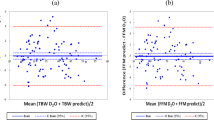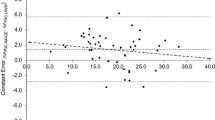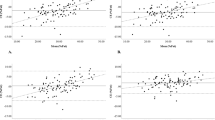Abstract
Objective: To examine the comparability of different methods to assess percentage body fat (BF%) against underwater weighing (UWW). Design: A meta-analysis on 54 papers, published in 1985–96, on healthy, adult Caucasians. Methods: The mean BF% from different studies were treated as single data points. In addition to UWW, the studies included one or more of the following methods: 3- or 4-component model, dual-energy X-ray absorptiometry (DXA), dual-energy photon absorptiometry, isotope dilution, bioimpedance (BIA), skinfolds or near-infrared interactance (NIR). Within each of the methods, the analyses were done separately for different mathematical functions, techniques or instruments. Main outcome measures: Bias (mean difference) and error (s.d. of difference) between BF% measured by UWW and the other methods. Results: The 4-component model gave 0.6 (95% confidence interval for the mean, CI: 0.1 to 1.2) BF% higher results than UWW. Also the 3-component model with body density and total body water (+1.4 BF%, 95% CI: +0.3 to +2.6), deuterium dilution (+1.5 BF%, 95% CI: +0.7 to +2.3), DXA by Norland (+7.2 BF%, 95% CI: 2.6 to 11.8) and BIA by Lukaski et al. (+2.0 BF%, 95% CI: 0.2 to 3.8) overestimated BF%, whereas BIA by Valhalla Scientific (−2.6 BF%, 95% CI: −4.5 to −0.6) and skinfold equations by Jackson et al. (−1.20, 95% CI: −2.3 to −0.1) showed a relative underestimation. The mean bias for the skinfold equation by Durnin & Womersley, against UWW, was 0.0 BF% (95% CI: −1.3 to 1.3). The correlation between the size of measurement and the mean difference was significant for only NIR (r=−0.77, P=0.003). Conclusions: The difference between any method and UWW is dependent on the study. However, some methods have a systematical tendency for relative over- or underestimation of BF%.
This is a preview of subscription content, access via your institution
Access options
Subscribe to this journal
Receive 12 print issues and online access
$259.00 per year
only $21.58 per issue
Buy this article
- Purchase on Springer Link
- Instant access to full article PDF
Prices may be subject to local taxes which are calculated during checkout
Similar content being viewed by others
Author information
Authors and Affiliations
Rights and permissions
About this article
Cite this article
Fogelholm, M., van Marken Lichtenbelt, W. Comparison of body composition methods: a literature analysis. Eur J Clin Nutr 51, 495–503 (1997). https://doi.org/10.1038/sj.ejcn.1600448
Received:
Revised:
Accepted:
Issue Date:
DOI: https://doi.org/10.1038/sj.ejcn.1600448
Keywords
This article is cited by
-
Comparisons of calorie restriction and structured exercise on reductions in visceral and abdominal subcutaneous adipose tissue: a systematic review
European Journal of Clinical Nutrition (2022)
-
No differences in the body fat after violating core bioelectrical impedance measurement assumptions
BMC Public Health (2021)
-
Normal weight obesity and the risk of diabetes in Chinese people: a 9-year population-based cohort study
Scientific Reports (2021)
-
Body fat percentage cutoffs for risk of cardiometabolic abnormalities in the Chinese adult population: a nationwide study
European Journal of Clinical Nutrition (2018)
-
Body composition-derived BMI cut-offs for overweight and obesity in Indians and Creoles of Mauritius: comparison with Caucasians
International Journal of Obesity (2016)



